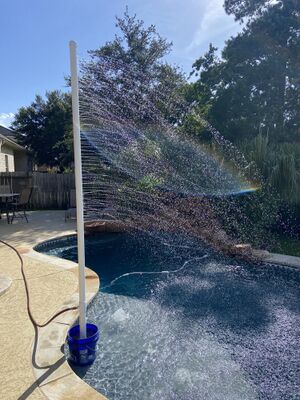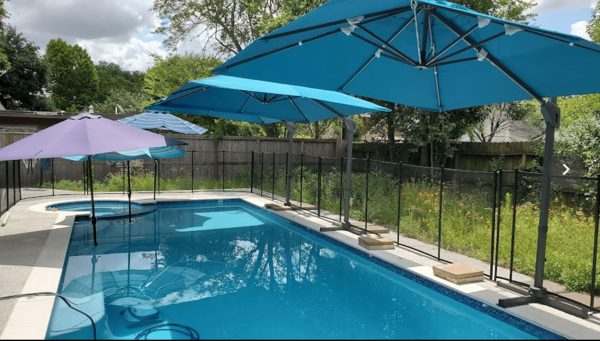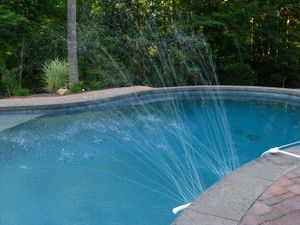Aeration and Misting Water
While we often hear of aeration being used to cool the water, you can find a milder solution, like using a water wand (fan spray) that lightly mists the surface of the water without generating the hard aeration normally used to increase pH. Do it in the late evening or early morning for the best impact.[1]
Using a pool cooler won't raise pH as quickly as aeration. You want a fine spray of droplets shooting high in the air to cool the water. Running it overnight is very helpful, and running it during the day and parking yourself under the arc of the spray feels a lot cooler![2]
Finding a way to shade part of the pool from the intense afternoon sun will help, too. Shade Sails are fairly easy to install and will provide shade for the pool.
Realize that in Arizona and other areas that have high CH in the fill water, using accelerated evaporation to cool your pool water also accelerates the calcium buildup in your water.[3]
The picture to the right is from the Redneck Evaporative Pool Cooler thread.
Heat Pump Chiller Mode
Some heat pumps have a Chiller Mode to cool the pool water.
Glacier Pool Coolers
Glacier Pool Coolers uses an electric fan and pump to cool water using misting within the unit. Operating requires only 120V AC and no Freon, gas, or heat exchanger.
The Installation Manual[4] describes two ways to hook the chiller to pool plumbing. One for existing pools and different plumbing for new pools using a dedicated return pipe. You should review the installation alternatives if you are considering the Glacier Cooler for a new pool.
The Installation Manual also says the GPC-23 and 25 models require a 2 X 2 pad, while the GPC-210 requires a 3 X 3 pad. The cooler must be installed at least 18 inches away from buildings, walls, or fences made from material that could degrade from water exposure. The coolers are open systems that may experience some water splatter or misting.
A sufficient supply of clean air and ventilation is needed around and above the unit. A minimum of a 5-foot clearance above the unit is necessary to avoid condensation on the structure above.
A member described the following adjustments he made to his Glacier Cooler to optimize the cooling:[5]
First I adjusted the wands so the streams are pointing more down and just barely to the right. This allowed for a lot more water to flow into the cooler without splashing all over the place. The wands were turning about 15 to 20 rpm (which is a little higher than recommended). Because more water was going in I opened the outlet valve a little more and was able to achieve the 2-3 minute cycle of the basin filling and then the pump kicking on to push the water out. (Prior to adjusting the wands the water flow was so slow the outlet valve was practically completely shut and the cycle time was probably well over 10 minutes.)
Lastly I shut off the return water from the main drain and set each skimmer return valve to only 1/2 way open. So more cool water was being pulled by the pump to mix with the skimmer return water. This was Jeff McGuire’s suggestion and I think it really helped. I could actually feel the colder water coming out of the pool returns jets. Before making these adjustments I wasn’t really able to feel any temperature difference in the water coming out of the return jets vs. the rest of the pool water.
Glacier Cooler Maintenance
Annual maintenance for the Glacier Cooler is hosing it off at the end of the summer, covering it with a tarp for the winter, and cleaning out the basin when starting back up.[6]
Glacier Cooler Repairs
The only parts subject to failure in the Glacier Cooler are the fan motor and the sump pump. The fan motors last around 5 years. People have needed to wait a while to get replacement fan motors from Glacier.
Glacier Cooler GC25 - DIY Fan Repair describes how a Walmart fan was used as a replacement for the fan in the Glacier Cooler.
Shading a Pool For Cooling
A member tried shading his Houston, TX pool using offset umbrellas and found it lowered the water temperature by about 6 degrees. You will find more details in Effective Pool Cooling for Hot Climates.
A Cheap Pool Cooler
This evaporator/aerator was put together with PVC pipe and is incredibly effective. A full sun pool will overheat without it, and with it, you may have to shut it off from time to time because the water gets a little cool.[7]
Remove one of the return eyeballs, and get the little plastic key that removes the inside collar that the eyeball screws into. Once that's out, a standard 1.5" threaded PVC will fit directly into the return pipe. Some PVC pieces will be glued to make four "jets" to elevate the water, and then 1/8" holes will be drilled on top of each.
Threaded 1.5" out of the pool wall, Tee-d off 1.5" for about 2' both ways. Then 3/4" for the four "uprights" (I used four 1.5 x 1.5 x .75 reducing Tee's to connect), Capped off the uprights, and drilled a 1/4" hole in the top of each one.
There is no magic in that design...make it out of whatever you have. The four 1/4" holes seemed to work out pretty well as far as the height of the fountain. Stay fairly close to that total surface area (.78 sq. in) to elevate the water as much as possible. If it doesn't shoot high enough, cap off one of your returns. No harm done....your psi will go up quite a bit.
The cooler works because of the evaporative process (which releases heat from the water) and works beautifully with hot temperatures. Opinion (not based on data) is that it is more effective during the day because of the lower relative humidity. In the Southwest, it would make icicles![8]
You can be in the pool and feel the cooler water dropping back to the surface. The higher you elevate the water, the smaller drops you can produce will give you the most effect. The volume of water you push into the air will have a lot of effect, too. A small, commercial fountain may work but doesn't produce much volume or elevation.
It's quite cheap and incredibly effective; the kids think it's fun.
Polaris Socket Cooler
Build a simple one that plugs into the Polaris socket. This way, you do not need to mess with the eyeball sockets, but the con is you have to run the booster pump for it to work.[9]
It has a simple design; the most expensive part is the Polaris socket. You may have to tweak the holes' size, number, and position to make them work for the pool, hence the sleeves after the T.
How I cool down my Pool
A member posted a nice video on how he cooled his pool in the thread How I Cool Down My Pool.
- ↑ https://www.troublefreepool.com/threads/aeration-and-water-temperature.169584/post-1494504
- ↑ https://www.troublefreepool.com/threads/aeration-and-water-temperature.169584/post-1494627
- ↑ https://www.troublefreepool.com/threads/aeration-and-water-temperature.169584/post-1494631
- ↑ http://images.inyopools.com/cloud/documents/newer-glacier-pool-chiller-manual.pdf
- ↑ https://www.troublefreepool.com/threads/glacier-pool-cooler-help.276315/post-2436136
- ↑ https://www.troublefreepool.com/threads/heater-chiller-recommendations.288767/post-2626502
- ↑ https://www.troublefreepool.com/threads/a-cheap-pool-cooler-for-the-end-of-summer.2331/post-18970
- ↑ https://www.troublefreepool.com/threads/a-cheap-pool-cooler-for-the-end-of-summer.2331/post-18974
- ↑ https://www.troublefreepool.com/threads/a-cheap-pool-cooler-for-the-end-of-summer.2331/post-58389






